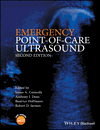Ultrasound Evaluation of the Acute Scrotum
Summary
Acute scrotal pain and/or swelling are common emergency department complaints. Ultrasound is a key component of the evaluation, as it is able to identify testicular torsion. Testicular ultrasound is performed with the patient in the supine position. Testicular evaluation begins with B-mode visualisation of the testicle size and parenchyma in the long and short axes, being sure to scan entirely through each testicle. The earliest B-mode finding is enlargement of the testicle due to vascular congestion. As torsion progresses there is a loss of the normal homogeneous echotexture, with areas of oedema, haemorrhage and necrosis. With colour or power Doppler examination the flow will be decreased or absent in the affected testicle. Epididymitis is inflammation of the epididymis, and the most common cause of inflammation within the scrotum. Ultrasound reveals enlargement and hyperaemia of the epididymal head, frequently with a concomitant hydrocele. Traumatic injury to the testicle may result in testicular fracture or intracapsular haematoma.



